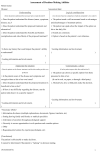Realizing the Wishes of Terminal Patients: Caregiving Transport Efforts for End of Life in the Kuji Area of Japan
- PMID: 34223502
- PMCID: PMC8241386
- DOI: 10.1089/pmr.2020.0113
Realizing the Wishes of Terminal Patients: Caregiving Transport Efforts for End of Life in the Kuji Area of Japan
Abstract
Background: There are some restrictions in Japan regarding end-of-life care. For example, only physicians can legally issue death certificates. By law, ambulance staff members perform cardiopulmonary resuscitation (CPR) for all patients with cardiopulmonary arrest (CPA). Therefore, it is difficult to transport patients to hospitals without CPR, even in cases of terminal patients with do-not-attempt-resuscitation (DNAR) order. Furthermore, there is no 24-hour home care nursing system in our area. Therefore, terminal patients are unable to spend their last moments at their home in the Kuji area. Objective: To design a system in which terminal patients who wish to spend their final moments at their home can be transported to the hospital without CPR after at-home CPA and a system to avoid confusion between ambulance staff and family members using instructions provided by the physician. Setting/Subjects: The subjects were terminal patients with DNAR order who wanted to stay at home. The instruction to not perform CPR after CPA was created as a document by physicians. Patient information was shared with the fire department; patients were transported to our hospital without CPR after at-home CPA. Results: In total, 26 patients died during the study period; eight received emergency transport to the hospital without CPR after CPA. CPR was not performed for any patient. Conclusion: A system transporting terminal patients without CPR after CPA was necessary in our area. This instruction allows terminal patients to spend their last moments where they wish and avoids unwanted CPR and troubles after CPA.
Keywords: cardiopulmonary resuscitation; do not resuscitate orders; do-not-attempt-resuscitation; instruction of physician; terminal patients.
© Mizunori Yaegashi et al., 2021; Published by Mary Ann Liebert, Inc.
Conflict of interest statement
No competing financial or any other interests exist. This article has not been published and will not be submitted elsewhere for publication while being considered by the Journal of Palliative Medicine.
Figures



Similar articles
-
Unwanted cardiopulmonary resuscitation against patients' "Do Not Attempt Resuscitation" orders in community settings in Japan: A narrative review.Geriatr Gerontol Int. 2024 Nov;24(11):1093-1098. doi: 10.1111/ggi.14993. Epub 2024 Oct 1. Geriatr Gerontol Int. 2024. PMID: 39353588 Free PMC article. Review.
-
'Do not attempt resuscitation' and 'cardiopulmonary resuscitation' in an inpatient setting: factors influencing physicians' decisions in Switzerland.Gerontology. 2011;57(5):414-21. doi: 10.1159/000319422. Epub 2010 Nov 23. Gerontology. 2011. PMID: 21099190
-
Do-Not-Attempt-Resuscitation Orders in Older Adult Patients With Out-of-Hospital Cardiac Arrest: A Single-Center Retrospective Study at an Urban University Hospital Emergency Department in Japan.Cureus. 2025 Feb 24;17(2):e79552. doi: 10.7759/cureus.79552. eCollection 2025 Feb. Cureus. 2025. PMID: 40144451 Free PMC article.
-
Usage of do-not-attempt-to-resuscitate orders in a Swedish community hospital - patient involvement, documentation and compliance.BMC Med Ethics. 2020 Aug 1;21(1):67. doi: 10.1186/s12910-020-00510-5. BMC Med Ethics. 2020. PMID: 32738915 Free PMC article.
-
[Small animal cardiopulmonary -resuscitation (CPR) in general practice].Schweiz Arch Tierheilkd. 2020 Dec;162(12):735-753. doi: 10.17236/sat00280. Schweiz Arch Tierheilkd. 2020. PMID: 33263542 Review. German.
Cited by
-
Changes in the rate of do-not-attempt-resuscitation orders in out-of-hospital cardiac arrest: a comparative study between 2019 and 2023.J Rural Med. 2025 Jul;20(3):182-188. doi: 10.2185/jrm.2024-055. Epub 2025 Jul 1. J Rural Med. 2025. PMID: 40636253 Free PMC article.
-
Unwanted cardiopulmonary resuscitation against patients' "Do Not Attempt Resuscitation" orders in community settings in Japan: A narrative review.Geriatr Gerontol Int. 2024 Nov;24(11):1093-1098. doi: 10.1111/ggi.14993. Epub 2024 Oct 1. Geriatr Gerontol Int. 2024. PMID: 39353588 Free PMC article. Review.
References
-
- Monitoring of Cancer Incidence in Japan MCIJ2017: Center for Cancer Control and Information Services Japan National Cancer Center. https://ganjoho.jp/reg_stat/statistics/stat/summary.html [in Japanese]. (Last accessed March31, 2020)
-
- Mori M, Ellison D, Ashikaga T, et al. : In-advance end-of-life discussions and the quality of inpatient end-of-life care: A pilot study in bereaved primary caregivers of advanced cancer patients. Support Care Cancer 2013;21:629–636 - PubMed
-
- Japanese Ministry of Health, Labour and Welfare: The Practice Guidelines for Process of Decision-Making regarding Treatment in the End-of-Life Care. https://www.mhlw.go.jp/file/04-Houdouhappyou-10802000-Iseikyoku-Shidouka... [in Japanese]. (Last accessed March14, 2018)
LinkOut - more resources
Full Text Sources
